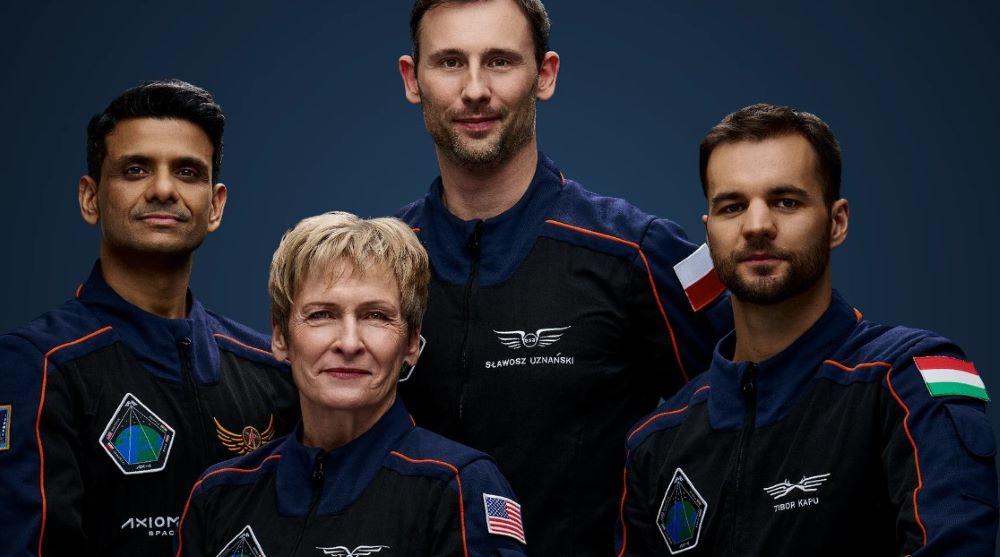This article is published in Aerospace Daily & Defense Report part of Aviation Week Intelligence Network (AWIN), and is complimentary through May 07, 2025. For information on becoming an AWIN Member to access more content like this, click here.

The Axiom Mission 4 crew, (left to right), Shubhanshu Shukla, Peggy Whitson, Sławosz Uznański-Wiśniewski, and Tibor Kapu.
HOUSTON—Axiom Space’s fourth four-person private astronaut mission (AX-4) to the International Space Station (ISS), set for May 29, appears to offer evidence of an expanding global interest in the scientific and economic potential to establish a sustainable commercial human presence in low Earth orbit.
AX-4 is slated for a 1:03 p.m. EDT liftoff from NASA’s Kennedy Space Center aboard a Falcon 9 rocket and Crew Dragon capsule. The mission agenda includes a 14-day visit to the ISS for a crew that includes astronauts from India, Poland and Hungary. They are led by Peggy Whitson, the Houston-based company’s human spaceflight director, a former NASA astronaut and ISS commander.
Their research agenda includes an estimated 60 projects, the most flown on an Axiom ISS private astronaut mission and representing sponsors from 31 countries.
“We are opening the door to countries where previously access to space has been through the ISS partners. We are opening the door to new countries, institutions and individuals that can bring new ideas that can really fuel the economy beyond Earth,” Lucie Low, Axiom’s chief scientist, told an April 29 news briefing.
Examples of the far-reaching scientific research planned by the AX-4 crew include “Suite Ride.” It is an initiative by Burgeel Holdings PLC, a United Arab Emirates health care service provider, to develop diabetes monitoring and treatment capabilities that would enable astronauts with insulin-dependent diabetes to participate in spaceflight missions. The effort builds on previous research that demonstrated commercially available insulin pens can deliver medications effective in microgravity that adhere to International Organization for Standardization (ISO) guidelines.
Another example is the Cancer in Low Earth Orbit project, led by the Sanford Stem Cell Institute of San Diego. It is a study of tumor organoid formation in microgravity to enhance the identification of early warning signs of cancer to improve prediction and prevention of the disease for patients on Earth.
The findings could also be critical to human space exploration through assessment of the impacts of low gravity and space radiation on cancer cell growth compared to cancer cell growth in humans on Earth.
Hungarian to Orbit (HUNOR) research initiatives will investigate how the space environment affects human bacterial, viral, and fungal microbiomes and study the impact of microgravity on human cognitive function and motor skills. HUNOR research will also assess low-melting point metals for the development of next-generation ion-jet propulsion systems and monitor crew radiation exposure and environmental conditions using personal dosimeters.
Axiom Space initiated its private astronaut missions with the 18-day AX-1 launched in April 2022. It was followed by the 10-day AX-2 launched in May 2023 and the 18-day AX-3 launched in January 2024.
Founded in 2016, Axiom Space is under a $140 million firm-fixed price indefinite-delivery contract awarded by NASA in February 2020. Axiom is to build a commercial space station to which the agency can transition its research and technology development activities now underway on the ISS as NASA prepares to safety deorbit the aging 15-nation ISS in 2030.
Whitson’s AX-4 crew includes the Indian Space Research Organization’s Shubhanshu Shukla, an air force pilot; Poland’s Sawosz Uznaski-Winiewski, a scientist, engineer and European Space Agency reserve astronaut; and Hungary’s Tibor Kapu, a mechanical engineer.
“Axiom-4 represents a milestone in our journey to advance human space exploration and scientific discovery,” Low noted. “These private astronaut missions actually make us ready ourselves for Axiom Station. So our private astronaut missions are designed to flesh out and test procedures, communications to all the nations, training and so much more. So when Axiom Station is ready to become independent of the ISS, the private astronauts, ground teams and the crews and the platforms they support will be fully functional and ready to hit the ground running.”
In December 2024, NASA and Axiom amended their plan for the assembly of the Axiom Station. The changes call for the commercial station’s Payload, Power, and Thermal Module to launch first and attach to the ISS U.S. segment. It is to depart by 2028 as a free-flyer two years earlier than initially planned and prepared to be joined by the Axiom Station’s Habitat 1 module, an airlock, the Habitat 2 module, and the Research and Manufacturing Facility module.
The Axiom Station assembly plan was initially to launch and attach its first module, Habitat 1, to the space station, followed by three additional modules before separating from the ISS.





